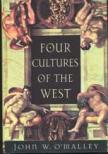Roots
There’s a well-worn Yiddish story about a yeshiva bokher (seminarian) who defiantly informs his old rabbi that he has become an apikoyres (unbeliever). And how long have you studied? asks the rabbi suspiciously. For five years, replies the young apostate. Ha! snorts the rabbi, five yearsand he calls himself an unbeliever! The point, of course, is that you can’t really reject any grand system unless you grasp it first. This sweeping survey of Western cultural history, by John W. O’Malley, S.J., ought to be required reading foramong othersliterary and philosophical apikorsim: post-modernists, New Agers, Generation-Xers and college students everywhere. It’s a clear, cogent survey of the cultural roots we all have, willy-nilly, consciously or otherwise.
In tackling Tertullian’s ageless question, What has Athens to do with Jerusalem? O’Malley knows there is no hard-wired taxonomy to fall back on. Hence the casual modesty of his title: the cultures of the West form a gigantic pie that could be (and has been) sliced up in many different ways. The four cultural strains he isolates are (1) the prophetic culture of Isaiah and Jeremiah (for starters); (2) the philosophical-scientific culture of Plato and Aristotle and their heirs; (3) the culture of Homer and Isocrates, Virgil and Cicero, the culture of poets and dramatists, or orators and statesmen; and (4) the culture of great Greek sculptors like Phidias and Praxiteles, of art and performance. All these cultures arose before the dawn of the Christian world, entered it, survived the downfall of the Roman Empire, leapt into prominence through a series of eureka-experiences of renaissances and reformations, from the 11th through the 16th centuries, and played a central role in creating what we call modernity. Where they go from here is not O’Malley’s concern in this book.
Despite all those eminent pagan names, O’Malley’s treatment of the mixes, matches and all-out wars in which the four cultures have engaged focuses not on general history (all the cultural doings of the past two and a half millennia), but on the history of Christianity. So the figures who dominate these pages will be the usual suspects: Origen, Augustine, Jerome, Francis of Assisi, Aquinas, Pope Gregory VII, St. Bernard, Erasmus, Luther, Calvin, and so on all the way down to William Lloyd Garrison and Martin Luther King Jr.
But being religious does not preclude sharp internal tensions. Aquinas’s Summa (O’Malley’s culture two, which culminated in the modern university) has no patience for the prophet’s repetition of the same battle cry. It has no time for the poet’s (culture three) circling around and around the same sentiment, or the politician’s recourse (three again) to values we all share.’ The Summa expresses the intellectual’s relentless quest.
Much of Christian history could be read, in fact, as the account of one culture taking one or more of the others to task for missing something essential. Early fathers of the church decried the polytheistic classical education that flowed in their blood. (The Jesuits later expended heroic energies teaching those same classics in both hemispheres.) Luther excoriated Scholastic theologyand Erasmian humanism. Protestants and some post-Baroque Catholics often mutilated the Gesamtkunstwerk of the liturgy (culture four). The cultures mingle and clash with one another, O’Malley shows, like currents in the ocean.
But the key to all four cultures is not a philosophical stance, but a medium or style: the prophet’s thunder, the academic’s careful exposition, the writer’s verbal magic, the untranslatable rhythms and harmonies of music and other arts. Michelangelo and J. S. Bach speak an entirely different language from those of the Council of Trent or Kierkegaard. And, in one further complication, all the cultures have contrasting contemplative and active aspects. Both monks and militants can be prophets. Culture two embraces both the ivory tower and the emergency room. Culture three harbors both very private poets and very public orators (whence Yeats’s dictum that out of our quarrels with others we make rhetoric, and out of our quarrels with ourselves we make poetry). Culture four includes both painters and performers.
In all this Father O’Malley (professor of church history at Weston Jesuit School of Theology, Cambridge, Mass.) makes an illuminating guide. His relaxed, agreeable prose (a blend of cultures two and three) should attract a wide spectrum of readers. Inevitably, though, he leaves two crucial questions unanswered: what do the major cultural patterns look like in Christianity today (to begin with, who are the leading figures?), and how does that picture relate to the swirling chaos of contemporary secular cultures? Perhaps he can shed some light on all that the next time around.
This article also appeared in print, under the headline “Roots,” in the December 20, 2004, issue.








